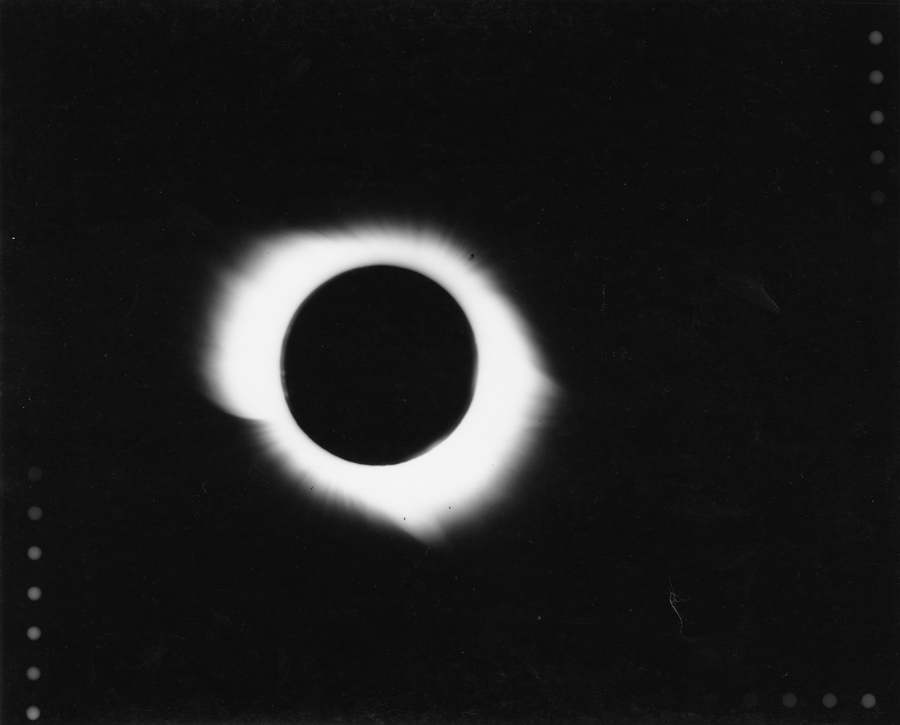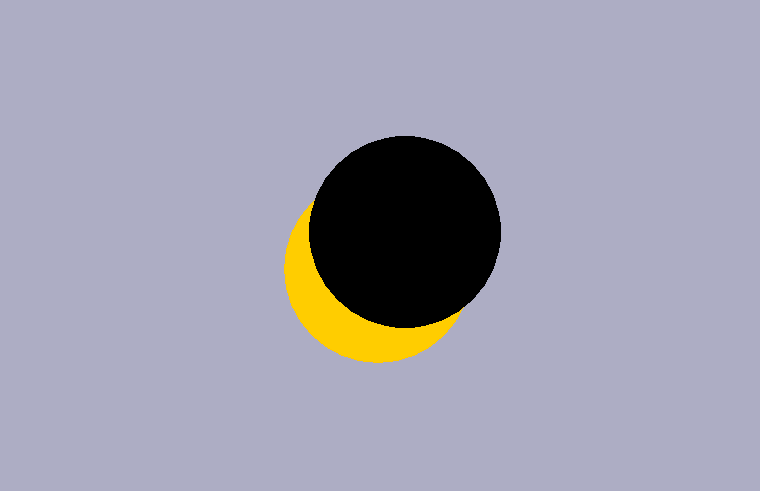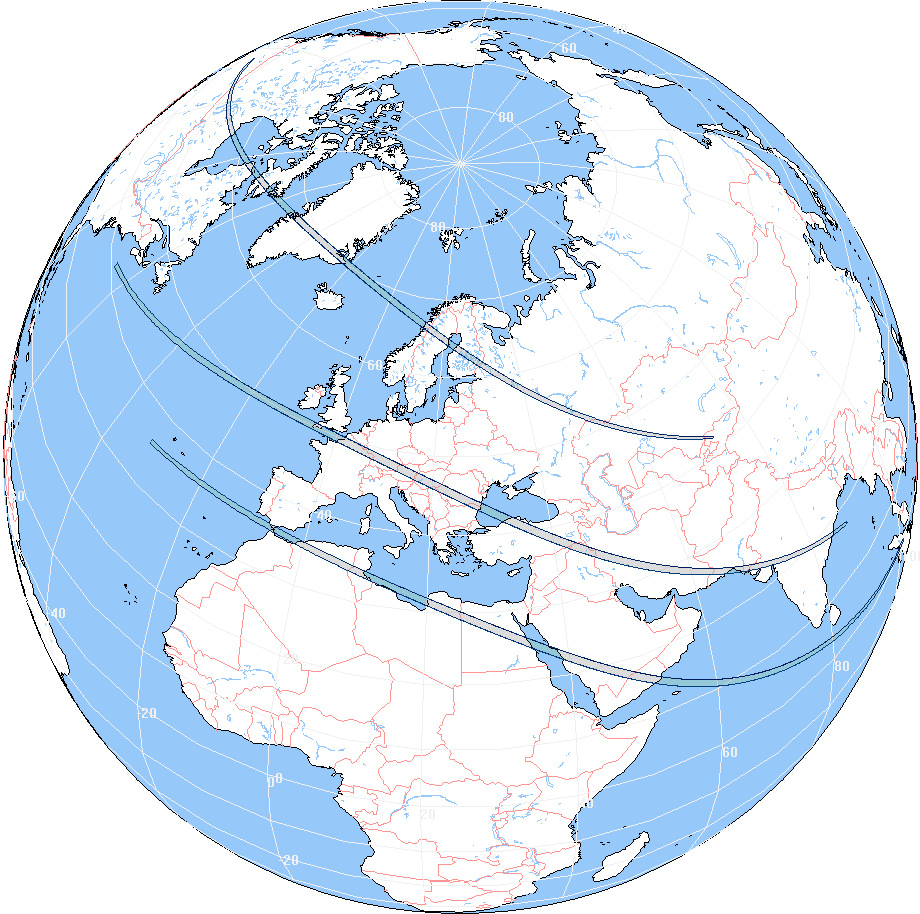SCANDINAVIAN ECLIPSETotale Sonnenfinsternis am 09.07.1945
IMPRESSUM EMAIL-KONTAKT © Sonnenfinsternis.org 2011-2017, all rights reserved |
| VORHERIGE SOFI | SOFI-CHRONIK | STARTSEITE | NÄCHSTE SOFI |
DIE SONNENFINSTERNIS AM 09.07.1945 IM RÜCKBLICK
Die Zentralzone der Sonnenfinsternis vom 09.07.1945 (Diagramm von Fred Espenak) zog sich vom Nordwesten der USA über Kanada, Grönland und Skandinavien bis in die Sowjetunion. In Deutschland war dies eine recht beachtliche Partielle Sonnenfinsternis; so wurde die Sonne im Norden Deutschlands am frühen Nachmittag zu etwa 2/3 vom Mond bedeckt. Doch zwei Monate nach Kriegsende wurde diese SoFi - wenn überhaupt - eher zufällig beobachtet, wie ein Augenzeugenbericht eindrucksvoll belegt.
In Cambridge/Massachusetts beobachteten Robert Dicke und Robert Beringer die Sonne während der dort partiellen Finsternis mit einer 45cm-Parabolantenne im hochfrequenten Radiobereich. Sie konnten nachweisen, dass die Strahlungsintensität mit zunehmender Bedeckung abnimmt [3]. In der Publikation der Ergebnisse wird zum ersten Mal überhaupt der Begriff "Mikrowellen" verwendet. 
Totale Sonnenfinsternis am 09.07.1945, aufgenommen von der Expedition des Yerkes Observatory am Pine River (Manitoba, Kanada).
Bildnachweis: University of Chicago Photographic Archive, apf6-04431, Special Collections Research Center, University of Chicago Library. Daten zur FinsternisAllgemeine Angaben
Kenndaten des Finsternismaximums
Quelle: NASA Solar Eclipse Page
Ablauf der Sonnenfinsternis am 09.07.1945.
Erstellt mit Win-Eclipse 3.5 von Heinz Scsibrany.

Sonnenfinsternis am 09.07.1945. Maximale Phase in Mitteleuropa: 70.5% (Rügen).
Die Totale Sonnenfinsternis vom 09.07.1945 war im Saros 145 die dritte Vorgängerin der legendären SoFi vom 11.08.1999, deren Zentralzone Mitteleuropa durchquerte. Dazwischen lag eine Exeligmos-Periode, und deshalb war die Finsternis vom 09.07.1945 im gleichen geografischen Längenbereich zu sehen wie die von 1999. Doch die Zentralzone verlief im hohen Norden Europas, also viel weiter nördlich als 1999. Gehen wir im Saros 145 noch eine Exeligmos-Periode weiter in die Zukunft, so stoßen wir auf die Totale Sonnenfinsternis vom 12.09.2053. Deren Zentralzone verläuft viel weiter südlich; Europa wird an der Straße von Gibraltar so gerade eben noch berührt. Die nachstehende Grafik zeigt, wie sich die Zentralzonen des Saros 145 im Verlauf von 2 Exeligmos-Perioden nach Süden verlagern. 
Drei totale Sonnenfinsternisse des Saros 145, die jeweils eine Exeligmos-Periode auseinander liegen. Von oben nach unten: 09.07.1945, 11.08.1999, 12.09.2053.
|
LITERATUR UND QUELLEN ZUR SONNENFINSTERNIS AM 09.07.1945Anonymus (1944): Total Solar Eclipse of June 9, 1945. Nature 154, 733. Alfvén, Hannes (1949): Results from observations of the total solar eclipse of 1945 July 9: II. Photoelectric intensity measurements of the corona and the sun during the eclipse. Stockholms Observatory Annaler 15 (6), 1-10. Bracher, K. (1985): The Total Solar Eclipse Of July 9, 1945. Publications of the Astronomical Society of the Pacific 97 (588), 199. Connor, A. J. (1945): July Weather Along the Path of Totality in Canada-Solar Eclipse July 9, 1945. Journal of the Royal Astronomical Society of Canada 39, 42-50. Davis, C. J.; Lockwood, M.; Bell, S. A.; Smith, J. A. & Clarke, E. M. (1945): Ionospheric measurements of relative coronal brightness during the total solar eclipses of 11 August, 1999 and 9 July, 1945. Annales Geophysicae 18 (2), 182-190. [3] Dicke, Robert H. & Beringer, Robert (1946): Microwave Radiation from the Sun and Moon. Astrophysical Journal, 103, 375. Diverse (1945): The Total Eclipse of the Sun, July 9, 1945. Journal of the Royal Astronomical Society of Canada 39, 255-260. [1] Grönstad, H. E. (1944): The total solar eclipse of 1945 July 9. Prediction for Scandinavia. Stockholms Observatory Annaler 14 (7), 1-36. Harang, Leiv (1945): Radio-Echo Observations at Tromsö during the Solar Eclipse on July 9, 1945. Journal of Geophysical Research 50 (4), 307-310. Hiltner, W. A. & Chandrasekhar, S. (1945): Photographs of the Corona Taken during the Total Eclipse of the Sun on July 9, 1945, at Pine River, Manitoba, Canada. Astrophysical Journal 102, 135-136. Johns, A. E. (1946): The Total Solar Eclipse of 1945. Journal of the Royal Astronomical Society of Canada 40, 81-99. Kristenson, Henrik (1955): Results from observations of the total solar eclipse of 1945 July 9: IV. Stockholms Observatory Annaler 18 (5), 1-19. [2] Millman, Peter M. (1947): Spectro-photometry of the solar corona, Royal Canadian Air Force Operation "Eclipse" July 9, 1945. Astronomical Journal 52, 157. Müller, H. (1948): Die ionosphärische totale Sonnenfinsternis vom 9. Juli 1945. Zeitschrift für Astrophysik 24, 59-67. Nicholson, S. B. (1945): Solar Activity at the Eclipse of July 9, 1945. Publications of the Astronomical Society of the Pacific 57 (337), 193-195. Öhman, Yngve (1944): Results from observations of the total solar eclipse of 1945 July 9: I. The polarization of the corona. Stockholms Observatory Annaler 15 (2), 1-72. Ramberg, Jöran M. (1951): Results from observations of the total solar eclipse of 1945 July 9: III. The photometry of the corona. Stockholms Observatory Annaler 16 (3), 1-51. Richardson, R. S. (1945): The Total Solar Eclipse Of July 9, 1945. Publications of the Astronomical Society of the Pacific 57 (335), 87-92. [4] Sander, K.F. (1947): Radio Noise from the Sun at 3.2 cm. Natur 159, 506-507. Smith-Rose, R. L. (1946): The Solar Eclipse of 1945 and Radio Wave Propagation. Nature 157 (3976), 40-42. Whitney, Walter T. (1945): Observations of the Total Solar Eclipse of July 9, 1945, at Opheim, Montana. Publications of the Astronomical Society of the Pacific 57 (337), 189-192. Waldmeier, Max (1947a): Die Korona während der Sonnenfinsternis vom 9. Juli 1945. Astronomische Mitteilungen der Eidgeno?ssischen Sternwarte Zu?rich 149, 1-26. Waldmeier, Max (1947b): Coronal Radiation and Ionospheric Variations during the Solar Eclipse, July 9, 1945. Journal of Geophysical Research 52 (3), 333-338. |